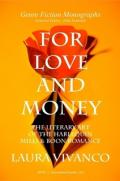
 For Love and Money: The Literary Art of the Harlequin Mills & Boon Romance. Tirril, Penrith: Humanities Ebooks, 2011.
For Love and Money: The Literary Art of the Harlequin Mills & Boon Romance. Tirril, Penrith: Humanities Ebooks, 2011.
"Laura Vivanco's For Love and Money is an impressive study of the popular fiction of Harlequin Mills and Boon that is a must read for any student of popular fiction and for those who write and love the genre" - Liz Fielding, author of over 50 Harlequin Mills & Boon romances.
"Deep learning, wide reading, and clear thinking are very much in evidence in Vivanco's exploration of HM&B. A welcome addition to popular romance criticism." - Professor Pamela Regis, author of A Natural History of the Romance Novel.
"Laura Vivanco’s For Love and Money is the book that scholars and fans have both been waiting for: a deft, attentive introduction to the Harlequin Mills & Boon romance novel as a work of art. [...] Vivanco traces the connections between these books and the classical myths and medieval romances they so often deliberately echo, and she shows how the novels use allusion and metatextual reflection to defend their genre. (“Scorn not the sonnet,” Wordsworth warned in a sonnet—Harlequin Mills & Boon novels have long taught readers to “scorn not the romance.”) Vivanco’s conversation with earlier critics, from the 1930s “Battle of the Brows” through 21st century scholars like Pamela Regis, is lively, engaging, and good-humored, and she has a remarkable eye for the textual details that bring each novel to life. I am profoundly impressed." - Professor Eric M. Selinger, author of What Is It Then Between Us? Traditions of Love in American Poetry.
The fame (or notoriety) of the Harlequin and Mills & Boon brands has led many to think reductively of HM&B romances as highly marketable mass-produced, commodities, churned out in accordance with a strict and unchanging formula. Certainly all their "Romance novels end happily. Readers insist on it" (Regis 9) and the commercial success of Harlequin Mills & Boon in meeting the demands of those readers is undeniable; it has been chronicled by Paul Grescoe in The Merchants of Venus: Inside Harlequin and the Empire of Romance and Joseph McAleer in Passion's Fortune: The Story of Mills & Boon. Although analysis of Harlequin Mills & Boon romances has demonstrated that their "themes vary from decade to decade and author to author" (Dixon 8), the study of these novels has tended to focus on their "sociological significance, revealing as they do the fantasies of millions of women" (Jensen 28). George Paizis is one of the few academics to examine not just the "politics of romantic fiction" but also its "poetics." He argues that "it is in its singular combination of fantasy and reality, tradition and experience, the collective and the individual that the romantic novel achieves its own effect" (176). For Love and Money explores these combinations in order to demonstrate that there is indeed a literary art of the Harlequin Mills & Boon romance.
Where to buy:
Ebook (PDF): ISBN 978-1-84760-195-7 from Humanities Ebooks
Print (paperback): ISBN 978-1-84760-196-4 from Amazon .ca .com .de .es .fr .uk, Barnes & Noble, The Book Depository.co.uk, The Book Depository.com and Lulu
Kindle: ISBN 978-1-84760-197-1 from Amazon .au .com .de .es .fr .it .uk
--------
Dixon, jay. The Romance Fiction of Mills & Boon, 1909–1990s. London: UCL Press, 1999.
Grescoe, Paul. The Merchants of Venus: Inside Harlequin and the Empire of Romance. Vancouver: Raincoast, 1996.
Jensen, Margaret Ann. Love’s $weet Return: The Harlequin Story. Toronto: Women’s Educational P, 1984.
McAleer, Joseph. Passion’s Fortune: The Story of Mills & Boon. Oxford: Oxford UP, 1999.
Paizis, George. Love and the Novel: The Poetics and Politics of Romantic Fiction. Houndmills, Basingstoke: Macmillan, 1998.
Regis, Pamela. A Natural History of the Romance Novel. Philadelphia: U of Pennsylvania P., 2003.
